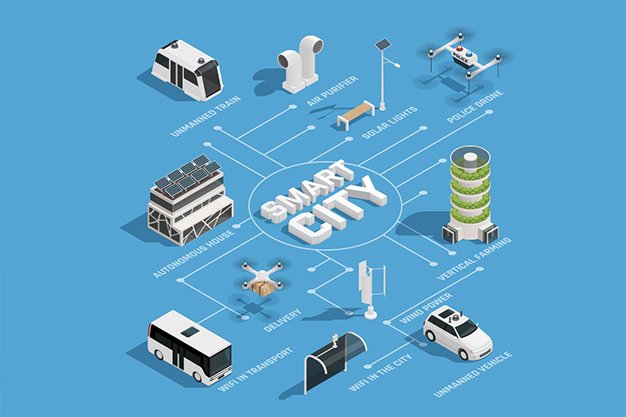Smart Citizen : Smart Cities The World Of Technology
Smart Cities The World Of Technology : The differentiating element between a digital city and a Smart City is Smart People. People are smart in terms of their skill and educational levels. As well as the quality of social interaction in terms of integration. Public life and their ability to open to the outside world.
Education and Training : Smart Cities The World Of Technology
• A key element in the development of cities is having well‐educated citizens. In addition to having well‐educated citizens and a university with a major presence in the city. Another priority is to adapt the educational offer. Especially considering the changes that society is going through due to globalization and the advancement of new technologies.
E-Learning
• New technologies are evolving at breakneck speed; Therefore, it is important to design digital development plans in classrooms that mainly focus on closing the digital divide. Promoting the digital skills of teachers and incorporating the new generation of digital learning resources.
• New technologies contribute to improving people’s education and training and, in that sense; virtual education offers many benefits, such as reduced costs, flexible hours and greater interaction.
Smart Energy : Smart Cities The World Of Technology
• The variable nature of power generation from renewable energy sources requires that networks, generation. Consumption connected in an efficient and intelligent way.
• To date, power supply has been governed by the consumption-oriented generation model. Because power will increasingly generated from renewable energy sources in the future. It is necessary that we move to a model based on principles of smart power generation. Smart power grids, smart storage, and smart consumption.
Smart Technology : Smart Cities The World Of Technology
• Technological development, supported by Innovation, is essential to offer competitive products and services. In addition to Research & Development, we must also promote innovation. Which includes areas such as new means of marketing and more efficient organizational and managerial systems.
• Smart City technologies developed to address a range of issues, including energy management. Water management, urban mobility, street lighting, and public safety, for example.
• These innovations underpinned by general developments in areas such as wireless communications. Sensor networks, data analytics, and cloud computing. The Smart City concept also driving new integrated approaches to city operations.
“Smart City technologies developed to address a range of issues. Including energy management, water management, urban mobility, street lighting, and public safety. These innovations underpinned by general developments in areas such as wireless communications, data analytics, and cloud computing.”

Smart Infrastructure
• Smart Infrastructure designs will need to be anticipatory and proactive to be truly sustainable. Much like an ecosystem, these will contain many small-scale, networked elements that serve a multitude of uses. Rather than one single guiding purpose for their existence.
• Urban community garden plots, for example, not only provide food for urban dwellers. But serve as storm water management systems. Allowing water and waste to recycled at the smallest scale with real-time. Sensors telling the centralized system how much less will have to be processed downstream.
• Cities will need to accurately measure current conditions, and model the future. Sensors and technological controls embedded within new and retrofitted urban designs could monitor existing conditions. Provide real-time feedback in case modifications needed.
Smart Mobility
• Smart Mobility aims to improve operational efficiency through linking traffic road information. The vehicle condition, real-time data acquisition and integration of urban traffic capacity. Thus achieving smooth flow of traffic running with RFID automatic toll collection technology and other data gathering instruments.
• Data collected mainly through the embedded RFID chip on public transport vehicles. Private cars, through video monitoring, coil monitoring, radar monitoring, floating car technology in real-time data acquisition, and GPS positioning.
• The data processing system offers decision making suggestion based on comprehensive data collected, providing forecasts. Optimization instructions based on corresponding databases, model bases, and knowledge bases. Upon this basis, a further development of application can used for traffic control. Coordinating among the police, control center personnel and drivers.
Smart Building
• At the most fundamental level, smart buildings deliver useful building services. Which make occupants productive (e.g. illumination, thermal comfort, air quality, physical security. Sanitation and many more) at the lowest cost and environmental. Impact over the building lifecycle.
• Reaching this vision requires adding intelligence from the beginning of design phase. Through to the end of the building’s useful life. Smart buildings use information technology during operation to connect a variety of subsystems. Which typically operate independently, so that these systems can share information to optimize total building performance.
• Smart buildings look beyond the building equipment within their four walls. They connected and responsive to the smart power grid, and they interact with building operators. Occupants to empower them with new levels of visibility and actionable information.
Smart Healthcare
• The application of new technologies in ways that affect health care, from diagnosis to monitoring patients. Including the management of the organizations involved in these activities, defined as Smart Healthcare.
• Smart Healthcare provides citizens with considerable advantages in terms of information. Even favors the availability of alternative diagnoses and of remote treatment or tele‐assistance.
• Through the use of new technologies, citizens can enjoy a number of on‐line medical services. Including key services such as requesting an appointment on‐line or the possibility of having a digital record.
CLICK HERE To Visit Our Website





